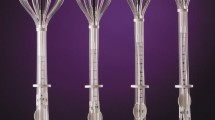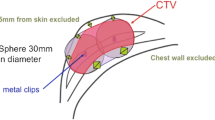Abstract
Background
A Japanese multi-institutional prospective study was initiated to investigate the effectiveness and safety of accelerated partial breast irradiation (APBI) using strut-adjusted volume implant (SAVI) brachytherapy, with subjects registered between 2016 and 2021. Herein, we report the preliminary results on the feasibility of this treatment modality in Japan, focusing on the registration process, dosimetry, and acute toxicities.
Patients and methods
Primary registration was conducted before breast-conserving surgery (BCS) and the eligibility criteria included the following: age ≥ 40 years, tumor unifocal and unicentric, ≤ 3 cm in diameter, cN0M0, proven ductal, mucinous, tubular, medullary, or lobular carcinoma by needle biopsy. Secondary registration was conducted after BCS had been performed leaving a cavity for device implantation and pathological evaluations, and the eligibility criteria were as follows: negative surgical margin, tumor ≤ 3 cm in diameter on gross pathological examination, histologically confirmed ductal, mucinous, tubular medullary, colloid, or lobular carcinoma, pN0, L0V0, no extensive ductal component, no initiation of chemotherapy within 2 weeks of the brachytherapy APBI planning with SAVI was performed for the patients successfully entered in the study by the secondary registration process, and the treatment was administered at the dose of 34 Gy in 10 fractions administered twice daily.
Results
Between 2016 and 2021, 64 women were enrolled in the study through primary registration, of which 19 were excluded from the secondary registration process, and in one, it was deemed impossible to comply with the dose constraints established during treatment planning. After the exclusion of these latter 20 patients, we treated the remaining 44 patients by APBI with SAVI. The dose constraints could be adhered to in all the patients, but re-planning was necessitated in 3 patients because of applicator movement during the treatment period. Grade 2 acute toxicities were observed in 18% of all patients, but more severe acute toxicities than Grade 2 were not observed in any of the patients.
Conclusion
APBI with SAVI brachytherapy is feasible in Japan from the aspects of compliance with dose constraints and frequency of acute toxicities.


Similar content being viewed by others
Data availability
All data relevant to the study are available from the corresponding author on reasonable request.
References
Early breast cancer trialists ‘collaborative group (EBCTCG)’. Effect of radiotherapy after breast-conserving surgery on 10-year recurrence and 15-year breast cancer death: meta-analysis of individual patient data for 10,801 women in 17 randomised trials. Lancet 2011; 378: 1707–1716.
Early breast cancer trialists ‘collaborative group (EBCTCG)’. Effects of radiotherapy and of differences in the extent of surgery for early breast cancer on local recurrence and 15-year survival: an overview of the randomised trials. Lancet 2005; 366: 2087–2106.
Showalter SL, Grover S, Sharma S, Lin L, Czerniecki BJ. Factors influencing surgical and adjuvant therapy in stage I breast cancer: a SEER 18 database analysis. Ann Surg Oncol. 2013;20:1287–94.
Strnad V, Ott OJ, Hildebrandt G, Kauer-Dorner D, Knauerhase H, Major T, Lyczek J, Guinot JL, Dunst J, Gutierrez Miguelez C, Slampa P, et al. 5-year results of accelerated partial breast irradiation using sole interstitial multicatheter brachytherapy versus whole-breast irradiation with boost after breast-conserving surgery for low-risk invasive and in-situ carcinoma of the female breast: a randomized, phase 3, non-inferiority trial. Lancet. 2016;387:229–38.
Vicini FA, Cecchini RS, White JR, Arthur DW, Julian TB, Rabinovitch RA, et al. Long-term primary results of accelerated partial breast irradiation after breast-conserving surgery for early-stage breast cancer: a randomized, phase 3, equivalence trial. Lancet. 2019;394:2155–64.
Yoshida K, Nose T, Masuda N, Yamazaki H, Kotsuma T, Yoshida M, et al. Preliminary result of accelerated partial breast irradiation after breast-conserving surgery. Breast Cancer. 2009;16:105–12.
Benitez PR, Keisch ME, Vicini F, Stolier A, Scroggins T, Walker A, et al. Five-year results: the initial clinical trial of Mammosite balloon brachytherapy for partial breast irradiation in early-stage breast cancer. Am J Surg. 2007;194:456–62.
Njeh CF, Saunders MW, Langton CM. Accelerated partial breast irradiation (APBI): a review of available techniques. Radiati Oncol. 2010;5:90.
Brashears JH, Dragun AE, Jenrette JM. Late chest wall toxicity after MammoSite breast brachytherapy. Brachytherapy. 2009;8:19–25.
Dragun AE, Harper JL, Jenrette JM, Sinha D, Cole DJ. Predictors of cosmetic outcome following MammoSite breast brachytherapy: a single-institution experience of 100 patients with two years of follow-up. Int J Radiat Oncol Biol Phys. 2007;68:354–8.
Scanderberg DJ, Yasher C, Rice R, Pawlicki T. Clinical implementation of a new HDR brachytherapy device for partial breast irradiation. Radiother Oncol. 2009;90:36–42.
Camberio M, Martinez-Regueira F, Rodriguez-Spiteri N, Olartecoechea B, Insausti LP, Elizalde A, et al. Multicatheter breast implant during breast conservative surgery: Novel approach to deliver accelerated partial breast irradiation. Brachytherapy. 2016;15:458–94.
Pohankova D, Sirak I, Jandik P, Kasaova L, Grepl J, Motycka P, et al. Accelerated partial breast irradiation with perioperative multicatheter interstitial brachytherapy- a feasibility study. Brachytherapy. 2018;17:949–55.
Yasher C, Attai D, Butler E, Einck J, Finkelstein S, Han B, et al. Strut-based accelerated partial breast irradiation: Report of treatment results for 250 consecutive patients at 5 years from a multicenter retrospective study. Brachytherapy. 2016;15:780–7.
Sawaki M, Miyamoto T, Fujisawa T, Itoh Y, Ebara T, Tachibana H, et al. Multicenter phase II study of intra-operative radiotherapy of early breast cancer: Ipsilateral tumor recurrence. Ann Surg Oncol. 2019;26:2428–34.
Strnad V, Hildebrandt G, Potter R, Hammer J, Hindemith M, Resch A, et al. Accelerated partial breast irradiation: 5-year results of the German-Austria multicenter phase II trial using interstitial multicatheter brachytherapy alone after breast-conserving surgery. Int J Radiat Oncol Biol Phis. 2011;80:17–24.
Yoshida K, Nose T, Otani Y, Asahi S, Tsukiyama I, Dokiya T, et al. A Japanese prospective multi-institutional feasibility study on accelerated partial breast irradiation using multicatheter interstitial brachytherapy: clinical results with a median follow-up of 60 months. Breast Cancer. 2022;29:636–44.
Nose T. APBI: Japanese experience and Asian trend. In Brachytherapy techiniques and evidence. In: Yoshioka Y, Itami J, Oguchi M, Nakano T, editors. Brachytherapy Singapore. Springer; 2019. P.209–20.
Mooney KE, Altman MB, Edward S, Garcia-Ramirez J, Thomas MA, Zoberi I, et la. Accelerated partial breast irradiation dosimetric criteria for the strut-adjusted volume implant. Brachytherapy 2016; 15: 616–624.
Orecchia R, Veronesi U, Maisonneuve P, Galimberti VE, Lazzari R, Veronesi P, et al. Intra-operative irradiation for early breast cnacer (ELIOT): long-term recurrence and survival outcomes from a single-centre, randomized, phase 3 equivalence trial. Lancet Oncol. 2021;22:597–608.
Acknowledgements
We thank the Working group of APBI with SAVIs in Japan: Yoshikazu Kagami, Yoshinori Ito, Kozo Murakami, Masako Kato, Rei Kobayashi, Satoshi Kubo, Takayuki Iwamoto, Norihisa Katayama, Hitoshi Ikushima, Chisato Tonoiso, Akiko Kubo, Masami Morimoto, Taeko Kawanaka, Yasufumi Shitakubo, Motoharu Sasaki, Nobuyasu Suganuma, Toshinari Yamashita, Tetsuo Nonaka, Yoko Harima, Satoaki Nakamura, Tomio Nakagawa, Kazuya Miyoshi, Hirotoshi Takahashi, Kana Takahashi, Hiroyuki Okamoto, Kazuma Toda, Keiko Nakagawa, Mio Kojima, Koji Sasamori, Mio Mori, Tomoyuki Fujioka, Goshi Oda. Furthermore, we thank Masahiko Oguchi, Tomoyuki Aruga, Satoshi Miyake for their support as members of the Efficacy and Safety Assessment Committee. This study was partially supported by The Japan Agency for Medical Research and Development (AMED, 19ck0106305h0003).
Author information
Authors and Affiliations
Consortia
Corresponding author
Ethics declarations
Conflict of interest
Takashi Kuwayama, Tadahiko Shien, and Ryo-ichi Yoshimura received an honorarium from Konica Minolta as speakers at the seminar.
Additional information
Publisher's Note
Springer Nature remains neutral with regard to jurisdictional claims in published maps and institutional affiliations.
About this article
Cite this article
Yoshida, M., Yoshimura, Ri., Notake, R. et al. Feasibility of accelerated partial breast irradiation with strut-adjusted volume implant brachytherapy in Japan focusing on dosimetry and acute toxicity: a Japanese multi-institutional prospective study. Breast Cancer 31, 75–83 (2024). https://doi.org/10.1007/s12282-023-01513-x
Received:
Accepted:
Published:
Issue Date:
DOI: https://doi.org/10.1007/s12282-023-01513-x




